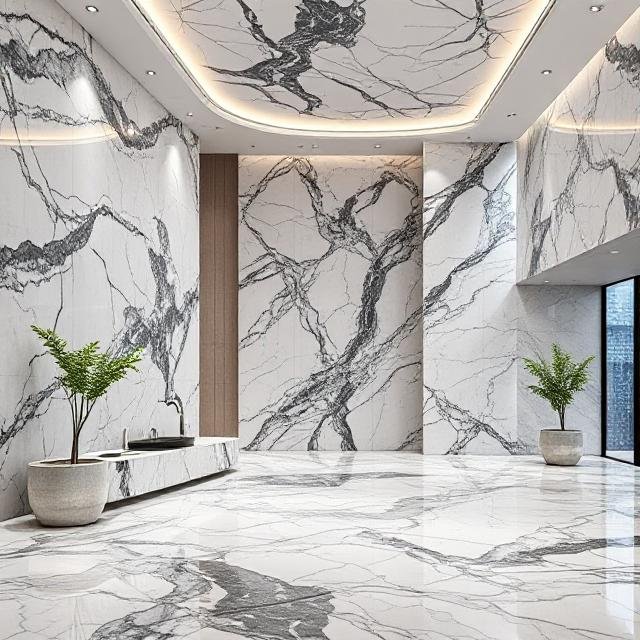In the marble industry, luxury and architectural designs are undergoing a tremendous transformation. In the traditional methods, there is a high chance of wastage of materials and operational inefficiencies, while in the smart system, artificial intelligence and specialized software management software integrated into the marble industry have paved the way for significant reduction in wastage and optimized operations. It is the era of precision in stone processing. In this article we will walk you through how AI can help in the reduction of marble wastage and optimize the operations.

AI: The Engine of Optimization
The core strength of AI in the marble industry is the ability to analyze massive datasets and understand the complex visuals beyond human capacity. It enables precision and predictive power.
How AI Reduces Waste and Optimizes Operations:
- Precision Cutting and Nesting:
- Using AI, it can scan the high-resolution images, like huge marble slabs, to identify the cracks, veining pattern, and fissures.
- The optimized algorithms help in optimal cutting plans to maximize the usable surface area for a particular order. The process involves identifying the required quantity of marble for a particular area in a specific cut size; this reduces marble wastage by almost 30% to 60%.
- In Michelangelo’s technique, visual planning plays a vital role in cutting down the possible waste by giving an automated and millimeter-precise.
- Predictive Quality Control:
- In machine learning, models are trained on thousands of flawless stones to identify the defect in the stone. They can detect the imperfections in real time on the production line with up to 98% accuracy; only the premium quality marble moves forward.
- For huge projects, consistency in the marble pattern is required. AI algorithms can help in analyzing the color intensity, pattern flow, and grain direction across the multiple slabs. Further, it suggests the best possible combinations and prevents the waste from misaligned pieces.
- Predictive Maintenance:
- IoT sensors on cutting saws, polishers, and other heavy machinery continuously monitor performance data such as vibration, temperature, and motor current.
- AI analyzes the pattern of marble to forecast the equipment failure before it occurs. By scheduling the maintenance, facilities minimize the production time and prevent material waste that results from machinery malfunctions.

The Role of Specialized Management Software
Using AI in the marble industry does miracles, but the usage of specialized management systems such as ERP and inventory systems is the central nervous system that ensures the business works together seamlessly.
- Unified Inventory Management: The software gives a real-time visual tracking of each marble block, like digital slab libraries, allowing the clients and architects to preview materials and plan designs virtually and select the right marble from the planning stage itself.
- End-to-End Traceability: From the quarry stage to final installation, the software tracks the stone’s journey. The software ensures quality, manages logistics, and supports regulatory compliance for eco-aware consumers.
- Demand Forecasting: By analyzing the sales data, current orders, and seasonal trends, AI can provide exact information to the management software. This leads to optimizing the raw material procurement and preventing costly overstocking.

Conclusion: Carving a Smarter Future
The convergence of AI and specialized management software is not just an upgrade; it’s a paradigm shift for the marble industry. Smart systems are moving manufacturers toward a future defined by operational excellence, unparalleled precision, and sustainability. By turning waste into value and manual processes into intelligent workflows, AI allows the timeless beauty of marble to be produced with 21st-century efficiency.
Frequently Asked Questions (FAQs)
Q: Is the initial investment in AI and software worth it?
A: Yes. Companies typically report a significant ROI through a substantial reduction in material waste (up to 60%), lower quality control costs (30-40%), and increased machine uptime due to predictive maintenance.
Q: Does this technology replace human craftsmanship?
A: No, it augments it. AI handles the highly repetitive, tedious, and precision-intensive tasks like defect detection and cut optimization. This frees up human craftsmen to focus on complex, bespoke projects and final artistic finishing.
Q: How does AI help with aesthetics and matching?
A: AI uses advanced computer vision to analyze and catalog unique vein patterns, colors, and textures. It then automatically matches multiple slabs for consistency across large installations, a task that is challenging and time-consuming for the human eye.
Q: Can this technology be applied to older machinery?
A: Often, yes. Existing machines can be retrofitted with IoT sensors and edge computing devices, allowing them to connect to the new digital network and feed data to the AI systems.


